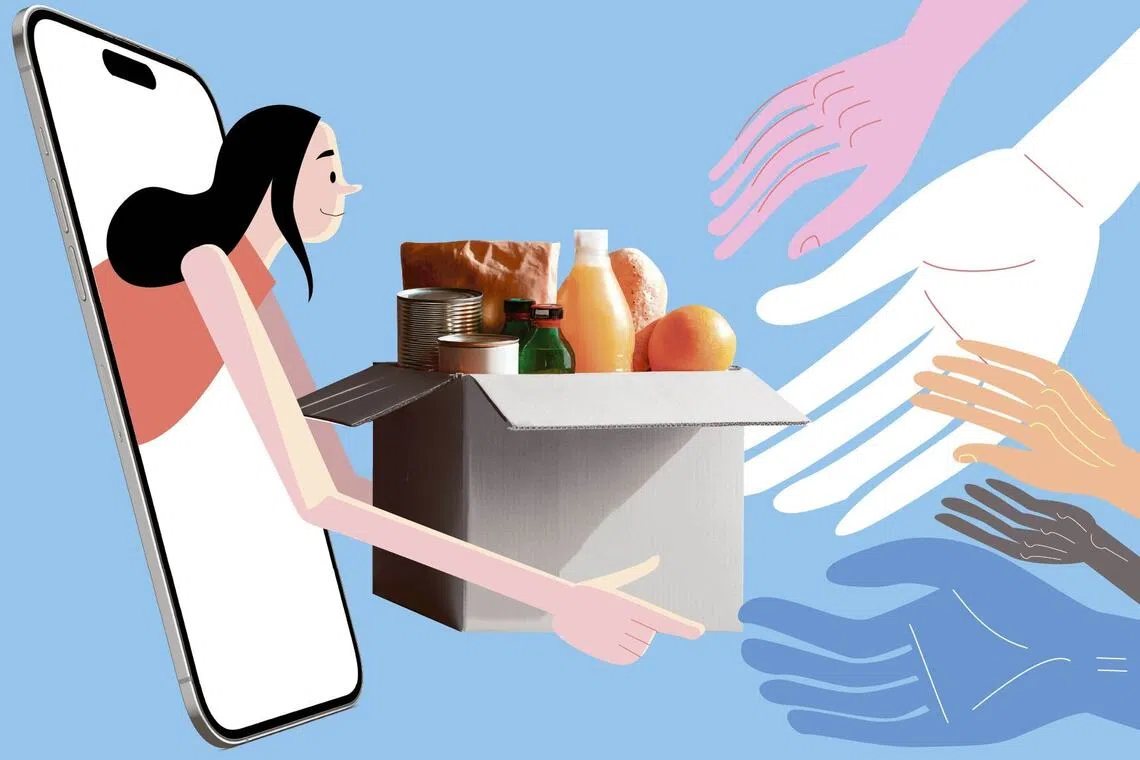Young & Savvy
‘Gotong royong’ is going strong on apps for offering giveaways
Sign up now: Get tips on how to grow your career and money

During the Covid-19 pandemic, users tapped the same hashtag to give away masks and hand sanitisers. This drove Carousell to create a “free items” category in 2020.
ST ILLUSTRATION: CEL GULAPA
Follow topic:
SINGAPORE - The request came unexpectedly, in response to my Carousell listing for a washing machine I recently purchased.
With years left on its warranty and life cycle, I had hoped to get $100 for it.
The machine would no longer fit into the layout of my home, which was about to undergo an extensive renovation. Still, I was determined to give it a new lease of life.
“Can you bless it to our ministry?” asked the Carousell user, who represented a charity.
It was the first such request I had received on the online marketplace.
The sceptic in me immediately wondered if this was a scam. I read the charity’s reviews and checked its registration records, before deciding to go ahead with the donation.
In days, the machine was out of my house and on the way to the charity, which supports former offenders and those in need.
The encounter opened my mind to the idea of giving things away using the online route.
I am admittedly late to the game. I have found that the #Blessings hashtag started trending on Carousell almost a decade ago.
A young single mother first used the hashtag to appeal for second-hand and new items. She received an overwhelming response.
During the Covid-19 pandemic, users tapped the same hashtag to give away masks and hand sanitisers. This drove Carousell to create a “free items” category in 2020.
Since then, about 350,000 to 400,000 free items have found new homes through the app every year.
Meanwhile, the Olio app, which has been operational here for several years, has supported the sharing of 2.3 million non-food items and almost 600,000 meals.
This reflects the increasing desire of Singaporeans to give away and receive second-hand items, in line with the growing trends of thrifting and upcycling.
However, I must add that the demand for free items is also being driven by people in need.
Olio, where most items are given away for free, has steadily added more than 1,000 users a month in 2024 and so far in 2025.
It says its main users are environmentally conscious households keen to reduce waste; families and students looking to save money; and people experiencing financial hardship.
The app expects its growth in users to continue, partly driven by the rising costs of living.
“Because Olio is all about sharing, community and sustainability, rather than charity or handouts, many users report that it feels inclusive and stigma-free,” a spokesperson told me. “Picking up from a neighbour, rather than queueing at a food bank, feels normalised and empowering.”
It made me wonder: Are sharing apps helping to keep alive the much-lauded kampung spirit or gotong royong? The unique Malay term refers to the sharing of resources to benefit a community.
As a millennial born in the 1990s, apps are the perfect medium for me, as I often prefer to communicate through messages.
I also find it hard to relate to stories about the close relationship that my parents and older relatives had with their neighbours, where financial struggles were discussed openly.
Now, my most common interactions with neighbours are in the lift, where we exchange friendly updates about our jobs and lives.
Out of curiosity, I started offering more items on sharing apps. My experience was pleasant and fuss-free.
Those who were interested typically offered to pick up the items from my home. Some even requested that the items be left on my doorstep for pickup, so no human interaction was required.
On rare occasions, users included an explanation for why they needed the items in their requests.
A printer and an entry-level DSLR camera were picked up in hours. I also managed to give away clothing, books and kitchen utensils.
I do not expect sharing apps to ever replace charities, which have established operations and can ensure that donations are going to the needy.
With apps, you simply have to trust that the items will be put to meaningful use, rather than being the latest addition to a hoarder’s stockpile.
There is also the concern of safety, especially when agreeing to have items picked up from one’s home.
Carousell recommends meeting up with users in public locations, or having company when users come to your home. Items can also be delivered via an in-app service, at additional cost.
I have found reviews of a user to be a good gauge of how a real-life interaction would go, allowing me to adjust my boundaries.
The app warns against taking conversations to external messaging platforms, or sharing banking details. It also advises users to report suspicious or fraudulent interactions.
The risks can be higher with food items and perishables. In this regard, Olio tells users not to share food that is past its use-by date, and to follow typical safety guidelines.
While writing this article, I contacted the charity to find out if my washing machine had been put to meaningful use.
I was told it had been sold via an app to raise funds.
It’s not how I had imagined it – I thought it would have been an essential appliance to residents at its halfway house.
But it reminded me that giving, at its core, would always be about letting go. Apps have emerged as just another avenue to give, with a little faith.

